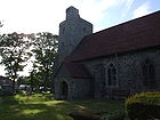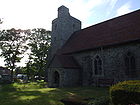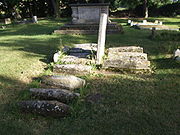
Cooling, Kent
Encyclopedia

Civil parish
In England, a civil parish is a territorial designation and, where they are found, the lowest tier of local government below districts and counties...
on the Hoo Peninsula
Hoo Peninsula
The Hoo Peninsula is a peninsula in England separating the estuaries of the rivers Thames and Medway. It is dominated by a line of sand and clay hills, surrounded by an extensive area of marshland composed of alluvial silt. The name Hoo is the Old English word for spur of land.-History:The Romans...
, overlooking the North Kent Marshes
North Kent Marshes
The North Kent Marshes, located in the north of the county of Kent on the Thames Estuary in south-east England, is one of 22 Environmentally Sensitive Areas recognised by the UK government's Department for Environment, Food and Rural Affairs...
. According to the 2001 census the parish had a population of 209.
This remote and isolated hamlet has been described as 'the capital of English Lollardry' because of its association with Sir John Oldcastle
John Oldcastle
Sir John Oldcastle , English Lollard leader, was son of Sir Richard Oldcastle of Almeley in northwest Herefordshire and grandson of another Sir John Oldcastle....
. The most notable feature of the village is Cooling Castle
Cooling Castle
Cooling Castle was built in the 1380s by John Cobham on the edge of marshes at Cooling, six miles north of Rochester, Kent. It is now about two miles inland. It was besieged by Thomas Wyatt the younger during Wyatt's rebellion in 1554; Lord Cobham surrendered after a brief resistance...
, built on the edge of the marshes during the 12th century to defend the neighbouring port of Cliffe from the threat of French raiders.
Cooling Castle
Sir John de CobhamJohn de Cobham, 3rd Baron Cobham
John de Cobham, 3rd Baron Cobham was the son of John de Cobham, 2nd Baron Cobham and Joan de Beauchamp. He was given a licence to crenellate by Richard II in 1381 and built Cooling Castle at the family seat in Cowling or Cooling, Kent....
, third Baron Cobham inherited a 700 acre (2.8 km²) estate at Cobham
Cobham, Kent
Cobham is a village and civil parish in the Gravesham District of Kent, England. It is located south of Watling Street, the old road from Dover to London, six miles south-east of Gravesend. The hamlet of Sole Street lies within the parish, which covers an area of 1,240 ha and has a population of...
from his father Henry in 1335, originally acquired by the de Cobhams in 1241. John Lord Cobham later built the castle in 1381, as he was in charge of the defence of Kent but a successful raid by the Spanish and French up to Gravesend spurred the king to realize the defence was needed. For in 1379 French vessels appeared in the Thames, with a body of French and Spanish soldiers who 'ravaged all this part of Kent', so that every town and village near the river fell to them. Sir John de Cobham died in a Monastery in Maiden-Bradley in 1408.
The castle, described as 'startling white-stone, drum-towered gatehouse and moated ruins of Cooling Castle' (Arnold), has two excellent and well proportioned half-round towers and entrance built by Thomas Crump of Maidstone
Maidstone
Maidstone is the county town of Kent, England, south-east of London. The River Medway runs through the centre of the town linking Maidstone to Rochester and the Thames Estuary. Historically, the river was a source and route for much of the town's trade. Maidstone was the centre of the agricultural...
. From the road, these are the most visible parts of the castle. The castle was constructed by the stonemason Henry Yeverle, who also worked extensively on the Palace of Westminster and the Tower of London. In 1381, the castle began to take shape, obtaining licence from King Richard to 'crenellate and fortify it'.
In 1413 the castle was owned by Sir John Oldcastle
John Oldcastle
Sir John Oldcastle , English Lollard leader, was son of Sir Richard Oldcastle of Almeley in northwest Herefordshire and grandson of another Sir John Oldcastle....
, the model for Shakespeare's character Falstaff
Falstaff
Sir John Falstaff is a fictional character who appears in three plays by William Shakespeare. In the two Henry IV plays, he is a companion to Prince Hal, the future King Henry V. A fat, vain, boastful, and cowardly knight, Falstaff leads the apparently wayward Prince Hal into trouble, and is...
.
The name of Brooke was derived from Sir Thomas Brooke, who was wed to the daughter and only surviving child of the Lady Joan de Cobham, by Sir Reginald Braybrooke. It was Braybrooke who bequeathed Cooling Castle into the de Cobham estate, although that family maintained Cobham Hall even then as its main residence.
Nevertheless, Cooling castle was stormed by Sir Thomas Wyatt
Thomas Wyatt the younger
Sir Thomas Wyatt the younger was a rebel leader during the reign of Queen Mary I of England; his rising is traditionally called "Wyatt's rebellion".-Birth and career:...
in 1554 during the Kentish uprising against Queen Mary
Mary I of England
Mary I was queen regnant of England and Ireland from July 1553 until her death.She was the only surviving child born of the ill-fated marriage of Henry VIII and his first wife Catherine of Aragon. Her younger half-brother, Edward VI, succeeded Henry in 1547...
and after the failure of Lord John Dudley
John Dudley, 1st Duke of Northumberland
John Dudley, 1st Duke of Northumberland, KG was an English general, admiral, and politician, who led the government of the young King Edward VI from 1550 until 1553, and unsuccessfully tried to install Lady Jane Grey on the English throne after the King's death...
, Duke of Northumberland to install Lady Jane Grey
Lady Jane Grey
Lady Jane Grey , also known as The Nine Days' Queen, was an English noblewoman who was de facto monarch of England from 10 July until 19 July 1553 and was subsequently executed...
on the throne.
That Sir Thomas Wyatt stormed Cooling Castle so easily may be explained by the interesting detail that the same was a nephew of Lord Cobham. Sir Thomas Wyatt was the son of Elizabeth Brooke, Cobham's sister, so his complicity with Dudley and Grey was 'a natural expression of his intimate love of England'. Wyatt held large estates in the Hundred of Hoo apart from those of his uncle, Lord Brooke of Cobham. His home was at Allington Castle on the River Medway.
It was George, Lord Cobham, in the year following his release from the Tower of London
Tower of London
Her Majesty's Royal Palace and Fortress, more commonly known as the Tower of London, is a historic castle on the north bank of the River Thames in central London, England. It lies within the London Borough of Tower Hamlets, separated from the eastern edge of the City of London by the open space...
, who was instructed to entertain Cardinal Pole during the papal legate's visit to England during a formal reconciliation with Rome
Rome
Rome is the capital of Italy and the country's largest and most populated city and comune, with over 2.7 million residents in . The city is located in the central-western portion of the Italian Peninsula, on the Tiber River within the Lazio region of Italy.Rome's history spans two and a half...
. This entertainment is recorded as having taken place at Cooling Castle, in about 1555, and is the last known reference to the Cobham family using the castle as a home. It had formally been somewhat damaged by the Duke of Norfolk's cannon in the attempt to force Wyatt's surrender during that uprising against Mary I.
During the 1990s the property was owned by the Rochester bridge wardens. The more recent residential parts of the castle are still in use — as at November 2008 it is owned by Jools Holland
Jools Holland
Julian Miles "Jools" Holland OBE, DL is an English pianist, bandleader, singer, composer, and television presenter. He was a founder of the band Squeeze and his work has involved him with many artists including Sting, Eric Clapton, George Harrison, The Who, David Gilmour and Bono.Holland is a...
.
St James' church

Churches Conservation Trust
The Churches Conservation Trust, which was initially known as the Redundant Churches Fund, is a charity whose purpose is to protect historic churches at risk, those that have been made redundant by the Church of England. The Trust was established by the Pastoral Measure of 1968...
and open to visitors daily. Jools Holland
Jools Holland
Julian Miles "Jools" Holland OBE, DL is an English pianist, bandleader, singer, composer, and television presenter. He was a founder of the band Squeeze and his work has involved him with many artists including Sting, Eric Clapton, George Harrison, The Who, David Gilmour and Bono.Holland is a...
was married there in August 2007. In the churchyard are a group of children's gravestones which are widely considered to have inspired Charles Dickens
Charles Dickens
Charles John Huffam Dickens was an English novelist, generally considered the greatest of the Victorian period. Dickens enjoyed a wider popularity and fame than had any previous author during his lifetime, and he remains popular, having been responsible for some of English literature's most iconic...
' description of the churchyard in the opening scene of the novel Great Expectations
Great Expectations
Great Expectations is a novel by Charles Dickens. It was first published in serial form in the publication All the Year Round from 1 December 1860 to August 1861. It has been adapted for stage and screen over 250 times....
.

